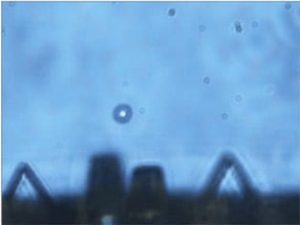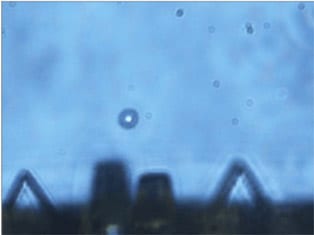Optical fiber devices for microfluidics integration open up new horizons for advanced “lab-on-a-chip” technologies.

Detection and trapping of molecules can be achieved with optical fibers directly located within the fluidic microchannel
Fluidic microsystems represent the bioanalytical platform of the future as they offer reduced sample volumes, faster and more sensitive biological assays, multi-sample and parallel analysis. The integration of microfluidics and photonic technologies has come to be known as optofluidics. An emerging area of optofluidics research is the integration of fiber optic technology with fluidic microchannel platforms in order to create fluidic microsystems with new or enhanced capabilities.
To date, the majority of cases where fiber optics are integrated with microfluidic channels have used the fiber optics merely as simple light guides. However, there are more innovative approaches where the optical fiber is modified to create a new sensing device or a manipulation tool that is located within the microchannel itself. In a review paper, Deepak Uttamchandani and Robert Blue from the University of Strathclyde (Glasgow, UK) summarize the recent emergence of miniaturized optical fiber based sensing and actuating devices that have been successfully integrated into fluidic microchannels that are part of microfluidic and lab-on-chip systems. Although a relatively small number of optical fiber devices have been demonstrated operating inside microchannels, the variety and inventiveness of the sensors and tools that have been achieved using the fiber optic/microfluidic platform combination is impressive and growing.
The versatility of the optical fiber platform has already allowed researchers to conduct immunoassays in microchannels using both fluorescently-labelled and label-free formats whilst gaining advantages of reduced assay time and increased sensitivity. For example, by functionalizing a tapered fiber with protein receptor molecules within a microchannel, four markers for an acute myocardial infarction in a blood sample could be measured simultaneously in less than 10 minutes. The authors also report on a label-free sensing approach which used an interferometer based on a tapered optical fiber. Another format measured the optical absorbance derived from a plasmonic resonance between the light and oscillating electrons in metal nanoparticles functionalized with bioreceptors and deposited on the fiber.
The authors present several approaches for optical fiber based measurements of refractive index and for absorption spectroscopy. For example, they describe a fiber optic probe for the measurement of surface-enhanced Raman scattering (SERS) from molecules within a microchannel. In another approach, the evanescent field of a tapered optical fiber was used to establish a whispering gallery mode (WGM) around a silica spherical resonator located in a microfluidic channel in order to measure the diameter of nanoparticles.
To estimate the flow rate within a microchannel, the bending of a fiber optic cantilever was measured. In another approach, the vibrations of a fiber cantilever placed parallel to the microchannel axis were used to determine both the flow rate and the liquid viscosity. Rather than just sensing, optical fibers can also be used to actively manipulate flow and materials present in the microchannel. For example, a microvalve for management of liquid flow control was constructed. It consisted of an optical fiber with a titanium film upon its end which functioned as a microheater for bubble generation within a fluid microchannel.
In addition, the authors discuss fiber optic devices for trapping and sorting biological material which will give researchers additional tools to conduct traditional experiments directly within a microchannel.
They are convinced that the emerging concept of “lab-on-fiber” will give the optical fiber platform additional (highly integrated) functionalities and is already demonstrating novel higher performance devices that can be applied to the fluidic microchannel. (K. Maedefessel-Herrmann)
See the original publication: Robert Blue andDeepak Uttamchandani, Recent advances in optical fiber devices for microfluidics integration, J. Biophotonics 9:1-2, 13-25 (2016)

















